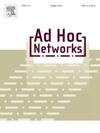关键任务物联网网络多路径数据传输中的可靠性感知分组复制
IF 4.8
3区 计算机科学
Q1 COMPUTER SCIENCE, INFORMATION SYSTEMS
引用次数: 0
摘要
关键任务型物联网应用需要至少99%的严格可靠性保证,以确保无缝运行。然而,由于物联网网络的资源有限性,数据传输本身就存在损失。这种矛盾对传统的低功耗和有损网络IPv6路由协议(RPL)提出了重大挑战,RPL最初是为通用物联网网络设计的。为了解决这个问题,已经提出了各种基于多路径rpl的路由方法。其中一种解决方案是可靠多路径RPL (RMP-RPL),它试图通过复制数据包并通过多个父端转发来提高可靠性。然而,当无线链路的错误率较高时,即使采用基于多父链路的方法,也很难满足可靠性要求。这是因为对于这样的链路,向每个父节点发送一次传输尝试是不够的。另一方面,增加父母的数量也受到许多因素的限制,比如资源消耗。为了解决这些问题,我们提出了多路径数据传输中的可靠性感知数据包复制(RAPID),它动态选择父节点的数量,并以最佳方式确定每个父节点的复制数据包数量,以满足可靠性约束,同时最大限度地减少冗余传输。该方案引入了联合传输率度量,并提出了基于贪婪(RAPID-G)和基于近似(RAPID-A)的分组复制策略来有效地管理分组复制。在Contiki COOJA模拟器上的实验结果表明,RAPID-A在不同的数据包接收率和网络密度下可以达到90%、95%和99%的可靠性要求,平均能耗比RMP-RPL降低34.23%。本文提出的协议RAPID-G在分组发送比、端到端延迟和能耗方面分别比LFC高出41.23%、39.23%和35.63%,RAPID-A在分组发送比、端到端延迟和能耗方面分别比LFC高出38.63%、44.12%和40.12%。本文章由计算机程序翻译,如有差异,请以英文原文为准。
Reliability-Aware Packet Replication in Multi-Path Data Transmission for Mission-Critical IoT Networks
Mission-critical IoT applications require a strict reliability guarantee of at least 99% to ensure seamless operation. However, due to the resource-constrained nature of IoT networks, data transmissions inherently suffer from losses. This contradiction presents significant challenges for the traditional IPv6 Routing Protocol for Low-Power and Lossy Networks (RPL), which was originally designed for general IoT networks. To address this issue, various multi-path RPL-based routing approaches have been proposed. One such solution is Reliable Multi-Path RPL (RMP-RPL), which attempts to enhance reliability by replicating packets and forwarding them through multiple parents. However, meeting the reliability requirement even with a multi-parent-based approach is difficult when the wireless links have high error rates. This is because one transmission attempt to each parent for a packet is not enough for such links. On the other hand, increasing the number of parents is also limited by many factors like resource consumption. To address these issues, we propose Reliability-Aware Packet Replication in Multi-Path Data Transmission (RAPID), which dynamically selects the number of parents and optimally determines the number of replicated packets per parent to meet the reliability constraint while minimizing redundant transmissions. The proposed scheme introduces a joint delivery ratio metric, and proposes greedy-based (RAPID-G) and approximation-based (RAPID-A) packet replication strategies to manage packet replication efficiently. Experimental results in Contiki COOJA simulator show that RAPID-A can achieve the reliability requirements of 90%, 95% and 99% under varying packet reception ratio and network density with an average energy consumption reduction of 34.23% as compared to RMP-RPL. The proposed protocol, RAPID-G, outperforms another multi-path algorithm, LFC, by 41.23%, 39.23% and 35.63% in terms of packet delivery ratio, end-to-end delay and energy consumption, respectively, and RAPID-A outperforms LFC by 38.63%, 44.12%, and 40.12% in terms of packet delivery ratio, end-to-end delay and energy consumption, respectively.
求助全文
通过发布文献求助,成功后即可免费获取论文全文。
去求助
来源期刊

Ad Hoc Networks
工程技术-电信学
CiteScore
10.20
自引率
4.20%
发文量
131
审稿时长
4.8 months
期刊介绍:
The Ad Hoc Networks is an international and archival journal providing a publication vehicle for complete coverage of all topics of interest to those involved in ad hoc and sensor networking areas. The Ad Hoc Networks considers original, high quality and unpublished contributions addressing all aspects of ad hoc and sensor networks. Specific areas of interest include, but are not limited to:
Mobile and Wireless Ad Hoc Networks
Sensor Networks
Wireless Local and Personal Area Networks
Home Networks
Ad Hoc Networks of Autonomous Intelligent Systems
Novel Architectures for Ad Hoc and Sensor Networks
Self-organizing Network Architectures and Protocols
Transport Layer Protocols
Routing protocols (unicast, multicast, geocast, etc.)
Media Access Control Techniques
Error Control Schemes
Power-Aware, Low-Power and Energy-Efficient Designs
Synchronization and Scheduling Issues
Mobility Management
Mobility-Tolerant Communication Protocols
Location Tracking and Location-based Services
Resource and Information Management
Security and Fault-Tolerance Issues
Hardware and Software Platforms, Systems, and Testbeds
Experimental and Prototype Results
Quality-of-Service Issues
Cross-Layer Interactions
Scalability Issues
Performance Analysis and Simulation of Protocols.
 求助内容:
求助内容: 应助结果提醒方式:
应助结果提醒方式:


